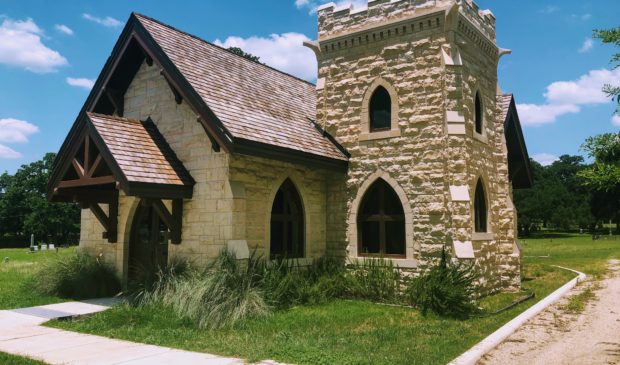City offered free DNA analysis of remains exhumed in Oakwood Cemetery chapel project
Wednesday, July 1, 2020 by
Ryan Thornton Years of analysis have revealed little information about the human remains of 36 bodies discovered buried beneath the Oakwood Cemetery Chapel in November 2016. Now a potential academic partnership between the Parks and Recreation Department and a biological anthropologist at the University of Connecticut could use minimally destructive methods of DNA testing to offer insights well beyond currently estimated details of sex, age and race.
“There’s a wide range of other information that can be gleaned from DNA testing that we think may be the only opportunity that we have to understand more about these individuals … things like diet, experiences with stress and trauma, and opening the window a bit into how they might have lived and where they may have come from regionally,” Kim McKnight, the department’s program manager of historic preservation, told the Human Rights Commission last week.
The department had decided against DNA testing soon after the remains were discovered while drilling for pier shaft support during construction of the new chapel. However, when Deborah Bolnick, whose anthropological work involves analyzing DNA samples from African American cemeteries in Texas and Georgia, presented the idea for a free genetic analysis, the department chose to reconsider.
“That’s something that felt very much out of reach for this project from a budget standpoint,” McKnight explained. “And we were also concerned about performing additional analysis that would be seen as very disruptive or invasive.”
But through ongoing discussions with Bolnick regarding the possibility of learning more about the genetic, social and historical context of these individuals, McKnight said some initial concerns have been resolved.
Bolnick’s proposed method of minimally disruptive DNA testing involves collecting tooth or bone samples that will be preserved while testing at the University of Connecticut ancient DNA lab and later returned to be reburied with the remains. Using the genetic information, Bolnick and fellow archaeologists Maria Franklin of the University of Texas and Samantha Archer, a University of Connecticut Ph.D. student, will seek to contextualize the lives and identities of the individuals beyond what we know today.
“We don’t know who these people are, but we do know that this part of the cemetery is most closely associated with Austin’s African American communities,” McKnight said.
Per the bio-archaeological report conducted by Texas State University’s Forensic Anthropology Center, most of the 20 adult remains were males, six were broadly categorized as white, six as “19th-century American black,” seven as “Mexican” and one as Asian, which could also indicate Native American heritage. What is clear, McKnight said, is that the bodies found in unmarked graves buried in this location were likely “disenfranchised people who didn’t have a voice.”
Conversations have only recently begun, but McKnight said the partnership could ultimately allow the department to identify whether any of the remains were related and whether they have any living descendants in the area, particularly among those whose family history may indicate a possible connection to someone buried in the vicinity.
Fred McGhee, a local archaeologist who has long called for DNA testing of the remains, said the city should take on the responsibility of identifying familial or cultural affiliations among the community. This would be similar to what is done for Native American remains under the Native American Graves Protection and Repatriation Act.
“The city needs to identify blood next of kin,” McGhee told the Austin Monitor on Tuesday. “If it can’t identify blood next of kin, it needs to identify cultural descendants, and then it needs to basically take its guidance from them as to proceed. If those descendants say ‘It’s okay, you can do research on the remains,’ then they have the proper sanctioning. But you cannot proceed until you have done that step; it’s a crucial step.”
The Austin Monitor’s work is made possible by donations from the community. Though our reporting covers donors from time to time, we are careful to keep business and editorial efforts separate while maintaining transparency. A complete list of donors is available here, and our code of ethics is explained here.
You're a community leader
And we’re honored you look to us for serious, in-depth news. You know a strong community needs local and dedicated watchdog reporting. We’re here for you and that won’t change. Now will you take the powerful next step and support our nonprofit news organization?








